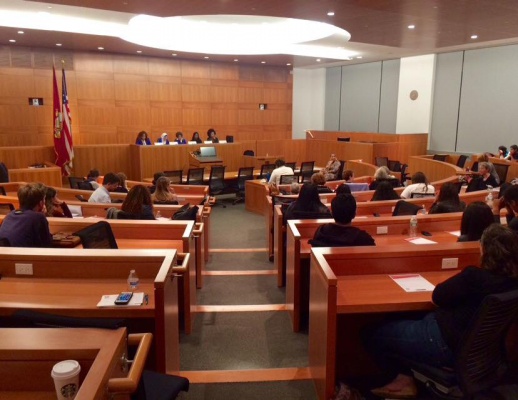A Blockchain Reaction to the Internet of Things
Last weekend, Dr. Lee W. McKnight frightened the crowd at a blockchain conference in the Law School. (CECILE NEIDIG/THE OBSERVER)
May 7, 2018
Before Dr. Lee W. McKnight of Syracuse University graced the podium at the Blockchain Disruptor Conference on April 28, 2018, event host Dr. Benjamin Cole told us, the audience, that he was “about to scare the bejesus out of [us].” Lo and behold, Dr. McKnight did not disappoint.
To begin his monologue, Dr. McKnight lectured the sold-out crowd—over capacity, actually, so some of us had the event streamed to us in another room—with fascinating factoids about the internet of Things (IoT). He discussed all the mechanics that go into making a device connected to the internet, ranging from hardware (including sensors), an interface, and an analytical software. He also discussed the prevalence of Things Network Communities—local chapters of a larger group dedicated to helping the IoT flourish—in New York City and Syracuse, the mere existence of which surprised me. He stated that there are about 23 million “things” connected to the internet today, but that that number is increasing and will have tripled seven years from now.
But the more frightening bits followed, for as the saying goes, we just can’t have nice things. 84 percent of people who own IoT devices—which include smartphones—have been hacked or breached, and most don’t know it. Malware, spyware and phishing are more common than most people think. In February, anyone who accessed a U.S. or U.K. government website helped mine cryptocurrency. When a report about the wide-open poor security of pacemakers was released to the public earlier this month, the market value of St. Jude, which makes and sells pacemakers, fell 10 percent. A few weeks ago, the city of Atlanta’s government computers were compromised by malware, the perpetrators demanding $51,000 worth of Bitcoin as ransom. Dr. McKnight went on to say that the fact that our number of “things” is on the uptick is incredibly dangerous considering how vulnerable these devices really are.
Dr. McKnight, clearly a bit shaken up by his own statistics, proposed a solution: blockchain integration. He calls it “Blockchain IoT with the Open Specifications Model V0.5,” and it attempts to create a sort of “authenticity of things.” The nature of blockchain is such that the data cannot be manipulated by anyone, only added. This makes the data inherently more secure. Moreover, the integrity of the data that is present in blockchain has the potential to be extraordinarily beneficial to IoT. It could close the gap between the usefulness of IoT and its insecurity by making the data safer and uneasily manipulated. As the “V0.5” portion of its name implies, the idea is still a prototype, but since Dr. McKnight went to the White House in 2015 to brief President Obama and his tech team on the promise of this idea, it must be serious.
As a student in the Digital Media and Technology concentration, this is relevant to my field of study. As a human being, this petrified me. I knew little to nothing about blockchain before this event, and I only knew about the positives of IoT. This one 25-minute speech by Dr. McKnight opened my eyes to the importance—and danger—of the two subjects, both when they are independent and when they are intertwined. We should be terrified. We should all be doing our research, and those of us who are educated enough to contribute should be doing all we can to improve Dr. McKnight’s idea and bring it to fruition.














